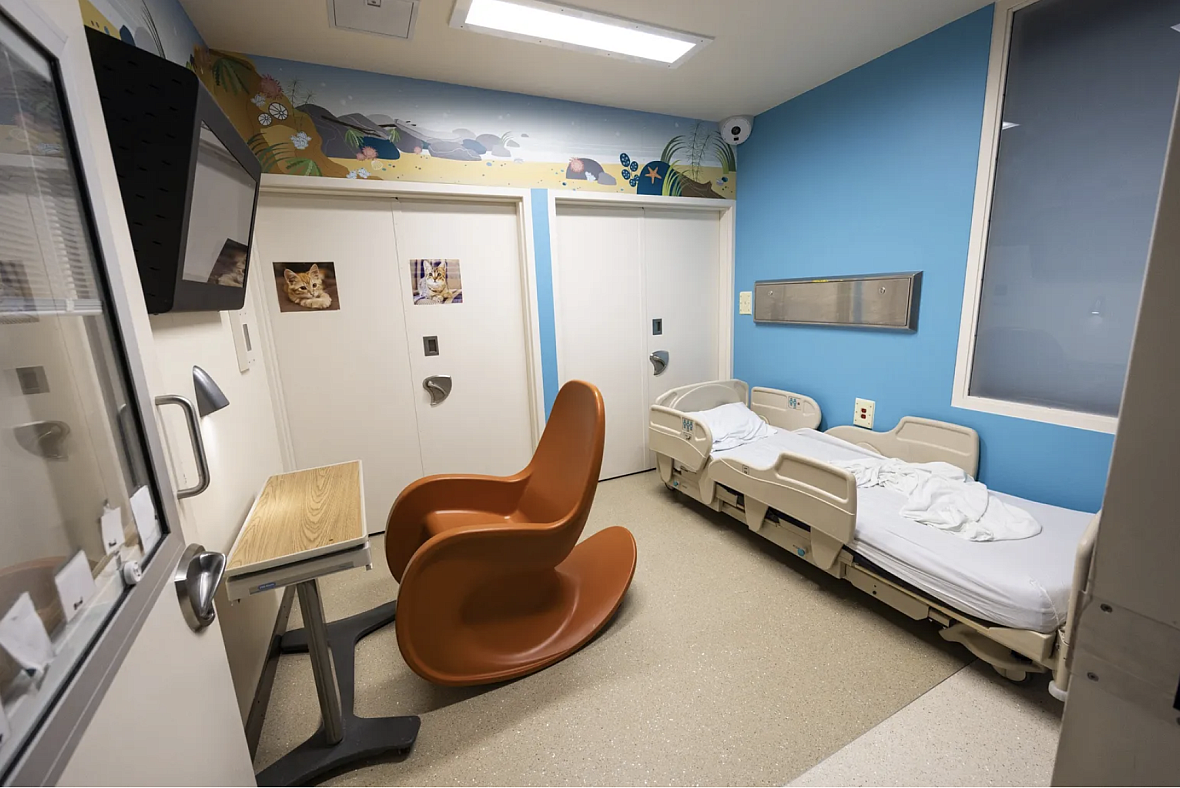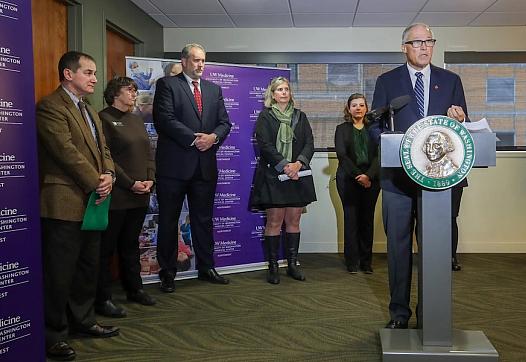Lawmakers pass bill to change how WA cares for youth stuck in hospitals
This story was originally published in The Seattle Times with support from the 2022 Data Fellowship.

A room inside the ER where a child has boarded for more than two months at Mary Bridge Children’s Hospital in Tacoma. Boarding is a term that refers to a person who lives in limbo inside a hospital unit that’s ill-suited to their needs. The window on the right is opaque glass and looks out to nothing.
(Amanda Snyder / The Seattle Times, 2022)
Washington lawmakers have passed legislation holding the governor’s office accountable for a growing crisis of children warehoused in hospitals awaiting psychiatric care, after a final unanimous Senate vote Wednesday.
Right now, no single state agency is responsible for finding appropriate psychiatric care for youth who are stuck inside the state’s hospitals, which is known as “boarding.” Every day, roughly 20 Washington children and teenagers with psychiatric needs are stuck waiting inside emergency departments and inpatient units. These youth can’t go home, but they also can’t get placement at facilities with specialized psychiatric care, or outpatient services they need.
The new legislation, House Bill 1580, centralizes responsibility for these youth in the governor’s office: It creates a new position called a care coordinator, who would be charged with creating a rapid response team and pooling state agency resources to help discharge children who are hospitalized but need psychiatric services or residential placement rather than general medical care. The coordinator would also have access to a special pot of funds to help find care or residential placement for kids with complex needs who can’t live at home.
“There needs to be accountability and there also needs to be collaboration to make sure that the children with these complex behavioral needs can access more appropriate care in a much more timely fashion,” state Sen. Claire Wilson, D-Auburn, said before the vote Wednesday.
The measure unanimously passed the House in March and now heads to Gov. Jay Inslee’s desk.
The number of youth in crisis was rising before the pandemic, but surged as COVID-19 took hold. While demand for care increased, access to behavioral health services shrank: School shutdowns cut off in-person special education programs, and several state and local programs stopped offering in-home therapy and family services. As more children and teens went without care, some devolved into such serious psychiatric states that they began to pose a threat to themselves or others. Emergency rooms became de facto dumping grounds for youth in crisis.
Now, dozens of kids are stuck inside windowless ER rooms for weeks. For others, it takes months — even years — to be discharged.
In the run-up to important votes in both of the state’s legislative chambers, lawmakers and hospital officials cited a yearlong Seattle Times investigation into the youth psychiatric boarding crisis. The total number of long psychiatric hospitalizations nearly doubled in recent years, The Times’ investigation found, and charges to government-paid insurance for such stays did double, totaling $151 million in 2021. The investigation also revealed that Child Protective Services is refusing to take children abandoned at hospitals into custody, and that the state is failing to follow a law that entitles youth to care in the community instead of inside institutions.
“You just have to pick up a headline — The Seattle Times has done a huge series on this work — to know that we do not have enough behavioral health resources for our children along the continuum of care,” bill sponsor Rep. Lisa Callan, D-Issaquah, said just before the House floor vote. “As a result, we are sending more and more of our children to emergency departments.”
Seattle Children’s senior state and federal government affairs director Hugh Ewart said the “reporting has been exceptionally helpful for this effort.”
Responsibility for the state’s child health and welfare services is split across several agencies. The Department of Social and Health Services, for example, oversees access to a broad range of therapeutic, in-home and residential services for people with disabilities. But some related programs, like the Children’s Long-term Inpatient Program and an intensive outpatient program known as WISe, are governed by a different agency, the Washington State Health Care Authority. Individual school districts are tasked with other responsibilities, like enrolling youth in special education programs. And the Department of Children, Youth & Families oversees services for children in foster care.
Piecing together the appropriate care for youth in crisis has proved difficult for families and caseworkers alike.
Last summer, Ewart said, Seattle Children’s convened with other hospital leaders and government agency officials to devise a legislative fix. The group included representatives from the state’s education and social services departments, as well as state health care officials, DCYF officials and administrators in the governor’s office, he said. It met every other week for several months, he said, before settling on many of the provisions outlined in HB 1580.
Ending the youth boarding crisis was also a priority for Callan, who helped lead support for the bill and related efforts as part of the chair of the state’s Children and Youth Behavioral Health Work Group. Youth boarding and mental health workforce concerns were the work group’s top legislative priorities this session.
The legislation has earned strong bipartisan support, drawing in lawmakers with personal ties to the youth mental health crisis, such as Republican Rep. Carolyn Eslick, of Sultan. Before casting a supportive vote for the bill in March, Eslick told her colleagues she’d taken in her 16-year-old grandson who’d received residential treatment outside Washington and had been kicked out by his parents, who couldn’t care for him. He could have easily become one of those kids stuck in the hospital, she said.
“The work that [Rep. Callan] has done on this is incredible,” Eslick said. “I just wish that I had thought of it. It is one of the best bills that’s on this floor this year.”
The association that represents hospitals across Washington also supports the measure, but pointed to gaps in care that would otherwise prevent youth from entering the hospital in the first place.
Youth with complex behavioral problems are supposed to have access to the state outpatient program called WISe, but a Seattle Times review of state data suggests many children who qualify for WISe face delays in treatment or don’t get care tailored to their needs. And naming a care coordinator won’t solve the fact that psychiatric beds are limited in the first place: Washington funds 94 inpatient psychiatric beds for children who need longer-term care, but providers say they’ve struggled to keep these beds online because of serious staffing shortages.
“I don’t think this is the end of this journey,” said Cara Helmer, policy director of legal affairs at the Washington State Hospital Association. “But I do hope that by bringing everyone to the table when a child is in this position — to look at the situation and say, ‘What do we need to provide for the family, what do we need to provide for this child, what resources do they need?’ — it will at least be a step in the right direction.”
It’s still early in the budgeting process — lawmakers only recently rolled out their budget proposals — but both chambers have proposed a set of budget increases aimed at reducing youth psychiatric boarding. Lawmakers want more than $2 million, for instance, to increase Medicaid reimbursement rates by 20% for certain providers who treat autistic children with complex needs. Additional proposals would continue funding for youth intensive outpatient and partial hospitalization pilot programs.


